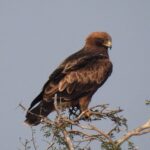Booted eagles, also known as Hieraaetus pennatus, are birds of prey that belong to the Accipitridae family. They have a diverse diet that includes various animals, such as birds, small mammals, reptiles, rodents, amphibians, and insects. However, booted eagles are also known to scavenge on carrion, which means they feed on dead animals.
Booted Eagles and Carrion Feeding
Booted eagles are opportunistic feeders, and they will take advantage of any available food source, including carrion. While they primarily hunt live prey, they have been observed scavenging on dead animals, particularly when their main prey is scarce or during times of food shortage.
Tawny eagles, a closely related species, are known to have a highly variable diet that includes a wide range of carrion. They have been recorded feeding on the carcasses of large animals, such as African bush elephants, and they often associate with vultures at carrion sites.
Factors Influencing Carrion Feeding in Booted Eagles
 Image source: Booted eagle By Dr. Raju Kasambe
Image source: Booted eagle By Dr. Raju Kasambe
There are several factors that can influence the frequency and extent of carrion feeding in booted eagles:
- Breeding Season: Booted eagles may scavenge more on carrion during the non-breeding season when their main prey is less abundant.
- Food Availability: When their primary prey is scarce or difficult to find, booted eagles may turn to carrion as an alternative food source.
- Habitat and Location: Booted eagles that live in areas with a high density of human settlements or near slaughterhouses may have more opportunities to scavenge on carrion.
- Presence of Vultures: Booted eagles may be more likely to scavenge on carrion when they can associate with vultures, which are efficient at locating and accessing carcasses.
Hunting and Scavenging Behavior of Booted Eagles
Booted eagles are skilled hunters and use a variety of techniques to capture their prey, including perching from a lookout, circling open country, and even chasing birds through the tree canopy. However, they have also been observed scavenging on carrion, particularly on roadsides where roadkill provides a steady food source.
When scavenging, booted eagles may land near a carcass and feed on the remains, or they may wait for an opportunity to displace other scavengers, such as vultures, and take over the food source.
Conclusion
In summary, booted eagles are opportunistic feeders that will not only hunt live prey but also scavenge on carrion when available. Tawny eagles, in particular, have a highly variable diet that includes a wide range of carrion, and they often associate with vultures at these feeding sites. The frequency and extent of carrion feeding in booted eagles can be influenced by factors such as breeding season, food availability, habitat, and the presence of other scavengers.
References:
– Booted Eagles (Ictinaetus Aquila)
– Tawny Eagle
– Hieraaetus pennatus

